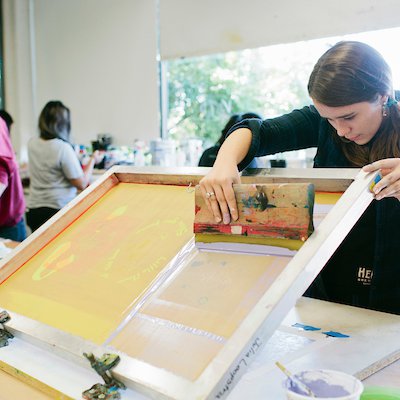The Necessary Guide to Recognizing Screen Printing and Its Versatile Utilizes
Screen printing has an abundant background that dates back to old times, progressing into a sophisticated technique used throughout various industries today. This guide explores the details of the screen printing procedure, detailing its applications in advertising and marketing, home, and fashion design - 10:9 Design Screen Printing. Understanding these fundamentals can open innovative capacity for both imaginative and industrial projects. The adhering to sections will expose important ideas and strategies to improve one's screen printing undertakings
The Background of Screen Printing
Although screen printing has roots that map back centuries, its advancement shows the technological and imaginative developments of numerous societies. Coming from ancient China, the strategy was originally made use of for decorating textiles and later infect Japan, where it became integral to Ukiyo-e woodblock printing. The approach moved to Europe in the 18th century, where it got appeal among craftsmens and business printers. The development of image solution in the 20th century transformed screen printing, enabling for more elaborate designs and higher efficiency. Musicians like Andy Warhol further thrust its popularity, utilizing the tool to create legendary jobs that mixed commercialism and fine art. By the late 20th century, screen printing had developed itself as a flexible method, used in style, advertising and marketing, and art. Today, it remains to advance, integrating electronic technology and expanding its applications across different markets.
The Screen Printing Process Explained
Screen printing transforms artistic visions right into substantial styles with a series of specific actions. An image is created and then transferred onto a screen, generally made of fine mesh material extended over a frame. A light-sensitive emulsion is applied to the screen, which is exposed to light, solidifying in areas not covered by the image. After rinsing the unhardened emulsion, a pattern is formed.
Next, the screen is put over the substrate, whether it be fabric, paper, or one more material. Ink is after that pushed via the open locations of the stencil using a squeegee, transferring the design onto the substrate listed below. This process can be duplicated for several colors, calling for separate displays for each and every hue. The published product is healed using heat to ensure the ink sticks appropriately, resulting in a resilient, dynamic layout ready for use.
Kinds of Screen Printing Techniques

Additionally, specialized techniques, such as discharge screen printing, eliminate dye from the material to create softer prints, while aluminum foil screen printing uses metallic aluminum foil to accomplish a shiny coating (10:9 Design LLC Company). Each method uses distinct qualities, dealing with various creative requirements and manufacturing ranges, ultimately expanding the possibilities within the screen printing domain
Applications of Screen Printing in Various Industries

Furthermore, the signage and advertising and marketing markets use screen printing for developing eye-catching display screens and banners. This method enables vibrant shades and detailed layouts that capture attention. In electronic devices, screen printing is utilized for applying conductive inks to circuit card, necessary for part connections. Furthermore, the home decoration sector welcomes screen printing to create distinctive layouts on fabrics and wall art. Overall, screen printing acts as a critical device throughout varied fields, boosting products with individualized and visually attractive graphics.
Tips for Successful Screen Printing Projects
While carrying out a screen printing job, cautious interest to detail can significantly enhance the final outcome. First, selecting top quality materials is crucial; this consists of the screen, inks, and substratums. Making use of ideal mesh matters can influence ink deposition and information resolution. Preparation is equally important; extensive cleaning of displays and appropriate exposure times ensure crisp prints.
Next off, exact registration is important for multi-color prints. Utilizing positioning devices can help accomplish specific layering. Furthermore, testing prints on scrap products before production assists recognize prospective problems without wasting resources.

Frequently Asked Inquiries
What Materials Are Finest for Screen Printing on Textile?
Cotton and polyester blends are excellent for screen printing on textile due to their longevity and ink absorption. Furthermore, specialized fabrics like silk or canvas can create unique textures and finishes, boosting the total design quality.
Just how Do I Clean and Maintain Screen Printing Equipment?
To cleanse and keep screen printing devices, one should regularly clean screens with appropriate solvents, inspect squeegees for wear, lube relocating components, and store all items in a dry, dust-free setting to extend their find more info life-span.
What Are the Environmental Influences of Screen Printing?
Screen printing can have substantial ecological influences, consisting of chemical waste from solvents and inks, water usage throughout cleansing procedures, and power consumption. Environment-friendly products and sustainable practices are necessary for decreasing these adverse effects.
Can Screen Printing Be Done in your home Properly?
Screen printing can be effectively done at home with the right materials and methods. Hobbyists can develop top quality prints, though success depends upon their skill level, devices, and understanding of the procedure involved.
What Are the Prices Connected With Beginning a Display Printing Organization?

Beginning a screen printing business involves expenses for tools, materials, and work area. First costs usually vary from a few hundred to numerous thousand dollars, depending upon the range, quality of equipment, and preferred production capability.
Screen printing has an abundant background that dates back to old times, evolving into an innovative strategy used throughout numerous industries today. Another next page strategy, rotating screen printing, utilizes round screens, promoting constant printing on textile rolls, therefore boosting performance for large-scale productions. Furthermore, specialty strategies, such as discharge screen printing, remove color from the fabric to develop softer prints, while foil screen printing applies metallic aluminum foil to attain a shiny surface. In the style sector, screen printing is widely made use of to produce vivid designs on clothing, allowing brand names to display their special styles. Cotton and polyester blends are ideal for screen printing on material due to their sturdiness and ink absorption.